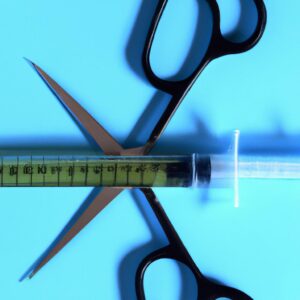Take Action: Unlock Your Cancer Prevention Potential

Introduction
With the rise of cancer diagnoses worldwide, prevention is more important than ever before. Fortunately, there are many routes to preventing a cancer diagnosis. This guide will discuss cancer screening options, lifestyle changes to reduce risk, and available support resources. Being informed about the options can help you make the best decisions for your health.
Cancer is caused when cells in the body begin to grow and divide abnormally. This growth may form a mass called a tumor, which can affect other parts of the body. If left untreated it can be fatal. Cancer screening identifies potential warning signs and tests for factors that indicate developing cancer, such as high levels of certain proteins in the blood. Making changes to lifestyle and environment can also reduce the risk of cancer. This means being aware of dietary ingredients, exercising, sun protection, reproductive health, tobacco and alcohol use, environmental exposure, and vaccinations.
Cancer Screening Options
Cancer screening is an important part of prevention. It helps identify potential cancerous cells in the body before they cause more serious damage. There are a number of different forms of cancer screenings, each with their own risks and benefits. Knowing which type of screening to get, and when to get it, is crucial for reducing your risk.
The most common type of cancer screening is a physical exam. During this exam, a doctor looks for any unusual changes, such as lumps or discoloration, that may indicate the presence of cancer cells. This is also a good time to ask questions about any symptoms you may be experiencing or lifestyle choices you can make to reduce your risk.
Other types of screening tests include mammograms for breast cancer, colonoscopies for colorectal cancer, Pap smears for cervical cancer, and PSA tests for prostate cancer. The frequency of these tests will vary depending on your age, gender, family history, and other factors.
It’s important to remember that screenings are only useful if done regularly. Most cancers grow slowly over time and can go unnoticed if not identified early. To maximize the effectiveness of your screenings, make sure to follow the recommended schedule for each type of test.
Finally, talk to your doctor about any special considerations when selecting a screening test. For example, some tests require special preparation, or may have certain risks associated with them. Make sure to ask any questions you may have to ensure that your screening experience is as safe and effective as possible.
Diet and Exercise for Cancer Prevention
Your diet and exercise habits can have a major impact on your risk of developing cancer. Eating a balanced diet rich in vegetables, fruits, whole grains, and lean proteins can help reduce your risk. Additionally, exercising regularly is important as it can help you maintain healthy weight and body composition.
Certain foods have been linked to cancer prevention. Cruciferous vegetables like kale, cabbage, and broccoli are examples of foods that have been linked to reduced risk of some cancers. Eating foods with antioxidant properties can also help protect your cells from damage that could potentially lead to cancer. Examples of antioxidant-rich foods include blueberries, dark chocolate, and nuts.
Exercise has a direct effect on reducing cancer risk. Physical activity helps manage weight, lowers inflammation, and supports healthy hormone levels, which are all factors that can play a role in preventing cancer. Aim to get at least 30 minutes of moderate physical activity each day, such as walking, biking, or swimming.
Incorporating a healthy lifestyle with a balanced diet and regular exercise is key to reducing your risk of developing cancer. Making simple changes to your daily routine can make a big difference in the long run. Enjoying an array of nutrient-dense foods, getting regular physical activity, and keeping your weight under control can all help reduce your risk of developing cancer.
Sun Protection
The sun is a great source of Vitamin D for us humans, but it can also be dangerous if not taken care of properly. Exposure to the sun’s ultraviolet (UV) radiation can increase your chances of skin cancer, which is why sun protection is so important. Here are some tips for protecting your skin and reducing your risk of skin cancer:
- Wear protective clothing – long pants and long-sleeved shirts can help protect your skin from UV radiation.
- Apply sunscreen with an SPF of at least 15 and UVA/UVB protection. Reapply it often and especially after swimming.
- Limit your time in the sun between 10am and 4pm, when UV radiation is strongest.
- Wear a hat and sunglasses when out in the sun.
- Avoid tanning beds and UV lamps.
It’s important to be aware of the risks of sun exposure and take steps to protect yourself. Taking these simple precautions can go a long way in helping you reduce your risk of skin cancer.
Vaccines
Vaccines are a safe and effective way to protect against certain types of cancer. Certain vaccines can help reduce the risk of developing cervical, liver, and stomach cancer. The most common vaccine for preventing cancer is the HPV vaccine, which helps protect against cervical cancer. Other vaccines also available, such as those for hepatitis B virus (HBV) and human papillomavirus (HPV), can provide protection from hepatitis and other diseases that can lead to liver and stomach cancer.
The effectiveness of vaccines varies based on factors such as age, health status, and lifestyle, but they are generally considered to be very effective in preventing cancer. Vaccinating children and adolescents is especially important, as it can help prevent certain types of cancer later in life. It’s also important to keep up with booster shots and/or schedule regular screenings to maintain the full protection provided by vaccines.
Reproductive Health
Women can reduce their risk of certain types of cancer by taking control of their reproductive health. Contraception is one important option; women can opt for a variety of long-term reversible contraceptive methods such as intrauterine devices (IUDs) or contraceptive implants to reduce their risk of contracting certain types of cancer. Additionally, women should be aware of the risks associated with having children, as pregnancy and childbirth increase the risk of certain reproductive cancers in women.
Women should also be aware of age-related risks, as the risk of certain types of cancers increases significantly with age. Women who are over 40 should get regular checkups to monitor their health and watch for signs of these conditions. Other considerations include maintaining a healthy weight, avoiding cigarettes, and seeking advice from a medical professional about any suspicious symptoms.
Overall, reproductive health is an important factor in overall cancer prevention. Women should be aware of the risks involved, as well as the preventive measures they can take to reduce their chances of developing certain types of cancer.
Tobacco and Alcohol Use
Smoking and drinking alcohol can have serious health consequences, including increasing the risk of developing certain types of cancer. Smoking is one of the leading causes of cancer and is linked to at least 20 different types of cancer. Alcohol is also connected to an increased risk of certain cancers, including breast, liver, and colorectal cancer.
It is important to know the risks associated with smoking and drinking and take steps to reduce their impact. Quitting smoking and limiting alcohol use are two key steps that can be taken to lower cancer risk. Those who are looking to quit smoking can find resources to help them through professional organizations and support groups.
Limiting alcohol intake is also important for reducing cancer risk. The American Cancer Society recommends not drinking alcohol at all, or no more than two alcoholic beverages per day for men and one per day for women. Additionally, special attention should be given to heavy drinking, as it can increase cancer risk.
Taking these steps to reduce or eliminate smoking and alcohol use can significantly decrease the risk of developing cancer. However, it is important to note that even if you do not smoke or drink, you may still be at risk for certain types of cancer. It is important to speak to a medical professional to discuss what further prevention methods may be necessary.
Environmental Factors
Being aware of environmental factors can help reduce the risk of cancer. There are many known carcinogens and pollutants present in our homes and workplaces that can increase cancer risk. Some of these include asbestos, benzene, and radon. It is important to take steps to reduce exposure to these substances.
To limit contact with carcinogens, start by checking for asbestos in your home and workplace. If you suspect it is present, hire a professional to remove it. Similarly, if you work with chemicals like benzene, take steps to ensure you are protected from inhaling the fumes. If the risks of radon exposure are present in your home, you can install a radon detector or have your house tested for radon levels.
It is also important to be mindful of other environmental factors like air pollution that can increase cancer risk. While you cannot control what is in the air outside, you can reduce your exposure to certain pollutants by avoiding physical activities in areas of high traffic. Additionally, ensuring that your home is well-ventilated and free of airborne pollutants like mold, dust, and pet dander can help reduce your disease risk.
Taking steps to reduce exposure to environmental carcinogens can be an effective way to reduce cancer risk. Knowing where these substances exist and how to avoid them can help keep you safe and healthy.
Support Resources
When it comes to cancer prevention, you’re not alone! There are a variety of professional organizations and support groups available that can provide helpful information and resources. These organizations can provide advice on everything from lifestyle changes to screening options and cancer treatments.
The American Cancer Society is one of the most well-known organizations dedicated to helping people affected by cancer. The society offers a wide range of services for cancer patients, such as providing emotional support, connecting people with local support groups, and helping victims apply for financial aid if needed. In addition to these services, the organization offers useful information about the latest cancer treatments and research.
Other specialized organizations are available to provide information specific to different types of cancer. For instance, the Breast Cancer Network of Strength provides support and informational resources for those affected by breast cancer, while the Lung Cancer Alliance offers a wealth of resources related to this type of cancer. Additionally, many hospitals have their own cancer centers or cancer support groups.
If you want to speak with someone directly, your doctor or nurse can provide you with contact information for reliable support services in your area. With so many organizations dedicated to providing cancer prevention information and support, you don’t have to go through this alone.
Summary
Cancer is a devastating illness, but there are several steps you can take to reduce your risk of developing it. This guide has discussed different screening options that are available, as well as lifestyle and environmental changes you can make to promote better health. Eating a healthy diet, exercising regularly, and protecting yourself from the sun’s harmful UV rays can go a long way in reducing cancer risk. Vaccines are also available for certain types of cancer, and certain reproductive health practices can reduce the risk as well. On the other hand, avoiding tobacco and excessive alcohol use is paramount. Additionally, reducing exposures to carcinogens and pollutants in the home and workplace can help protect against cancer. Professional organizations and support groups can provide information and resources for those affected by cancer or at risk for developing it. Taking proactive steps to prevent cancer is essential.
FAQs
When it comes to cancer prevention, many people have questions. It’s important to understand the risks and steps you can take to reduce the chance of developing cancer, so here are some commonly asked questions about cancer prevention.
- What should I do to reduce my risk of cancer? – There are several lifestyle changes that you can make to lower your risk of cancer, such as quitting smoking, eating a balanced diet, getting regular exercise, and protecting your skin from UV radiation. Vaccinations also have the potential to reduce your risk of certain types of cancer.
- Do I need to have regular cancer screenings? – Regular cancer screenings may be recommended depending on your age, gender, family history, and other factors. Talk to your doctor about what screenings are best for you, and when you should have them.
- How can I tell if I’m at risk of cancer? – Factors such as age, gender, family history, and lifestyle choices can all influence your risk of developing cancer. Your doctor can help you assess your individual risk for cancer and provide recommendations for reducing it.
Remember to always consult with your doctor to determine what cancer prevention measures are right for you.
Conclusion
Cancer prevention is an important part of maintaining a healthy lifestyle, and it’s important to take proactive steps to reduce your risk. Taking steps like getting regular cancer screenings, protecting your skin from UV radiation, watching your diet and exercising, avoiding tobacco and alcohol, and knowing what environmental carcinogens to avoid can make a big difference in preventing cancer. Additionally, there are many resources available to help you make informed decisions about your health choices and to provide support during these times.
We hope that this guide has given you insight into the various approaches available to reduce your risk of developing certain types of cancer. It is important to remember that not all cancers can be prevented, but taking these simple steps can drastically improve your chances of living a long and healthy life.
comments: 0







